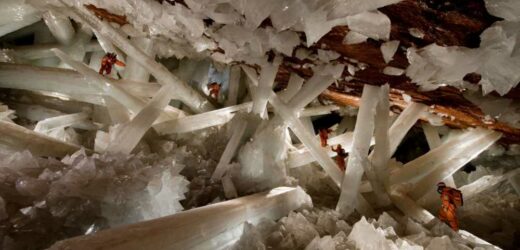CONCEALED 1,000ft below the ground lies a treacherous cavern filled with enormous crystals capable of killing visitors in a matter of minutes.
Anchored to the walls of the blistering hot cave that is as deadly as it is beautiful are hundreds of otherworldly crystals that grew uninterrupted for at least half a million years.
The dazzling glass-like shards deep beneath the Sierra de Naica Mountain in the heart of Chihuahua, Mexico, are up to 36ft long and weigh up to a staggering 55 tonnes.
The spectacular yet treacherous cavern remained one of Earth's secrets for thousands of years despite the neighbouring Naica Mine being worked for centuries.
Two unsuspecting miners stumbled across the natural marvel – now named Giant Crystal Cave -in 2000 while excavating a new tunnel for a mining company.
Towering above them were endless luminous milky-white crystals – some of the largest ever discovered.
More world news
China carrying out Taiwan invasion ‘dry run’ with mysterious ‘dark fleet’
Putin’s warlord warns ‘stop Ukraine war now’ in shock call to end slaughter
But these jagged crystals did not achieve their monumental form overnight.
Scientists who risked their lives by venturing into the cave believe it could have taken between 500,000 and 900,000 years for them to grow, according to How Stuff Works.
An uprising of magma millions of years ago forced hot, mineral-rich waters into the cavern, which spans as wide as a football pitch and as high as two-storey building.
The gypsum minerals packed in the water coupled with a magma chamber below the grotto acting like a cooker provided the perfect condition for the crystals to form.
Most read in The Sun
I want to be a dad again, says Simon Cowell – it will be hard but I'm desperate
Amy Childs reveals her twin babies' sweet names a week after 'exhausting' labour
The Script star Mark Sheehandies in hospital aged 46 after short illness
BBC broadcast interrupted as presenter suffers heart problem live on air
A steady heat was maintained for hundreds of thousands of years – causing the gypsum in the water to transform into selenite crystals.
The lethal translucent beams now measure up to 36ft long and many are even wide enough to be walked along.
They are too hot for a bare hand to touch and are razor-sharp yet as soft as human fingernails.
Although equipped with the assets to make it the perfect tourist hotspot, the cave has all the makings of a death trap and has been mostly inaccessible since it was discovered.
The air is acidic and temperatures can hit sweltering highs of 58C with humidity levels close to 100 per cent.
If not clad in proper protection, visitors can only endure the cave's killer conditions for under 10 minutes before a build-up of fluid in the lungs becomes potentially fatal.
Members of the public are barred from entering the cave for their own safety, and even scientists must get special permission.
But even wearing heat-protection suits and breathing apparatus, they can only tolerate the cave's conditions for around 15 to 60 minutes before likely losing consciousness.
Pictures from Protect Naica show researchers inside the cave totally dwarfed by the enormity of the crystals spewing out in all directions.
In 2017, biologists made the astounding discovery of a life form trapped inside the crystals estimated to be around 50,000 years old.
A team of NASA microbiologists found the microbes – which are too small to be seen without a microscope – lurking within the fluid in the shards.
Researchers believe the microbes are able to live off manganese, iron and other metallic elements present in the crystals.
Announcing the remarkable find at the American Association for the Advancement of Science that year, Penelope Boston – chief of NASA’s Astrobiology Institute – described the microbes as "super life".
She said: "These organisms have been dormant but viable for geologically significant periods of time, and they can be released due to other geological processes.
"This has profound effects on how we try to understand the evolutionary history of microbial life on this planet."
But it is unlikely the cave will ever be explored again as it reflooded in recent years after mining operations ceased.
Read More on The Sun
Tesco shoppers rush to buy ‘bargain’ baby essential scanning at £130 less
My six-month-old baby is toilet trained – he grunts when he needs to go
The cave's accessibility was dependent on the mine's water pumps, which were stopped in 2017 – allowing groundwater to refill the cave.
For two almost decades, the crystals were exposed to air, but now resubmerged in water it is believed they may have started growing again.
Source: Read Full Article
















